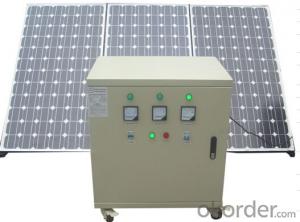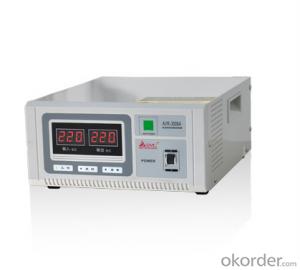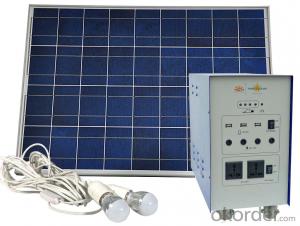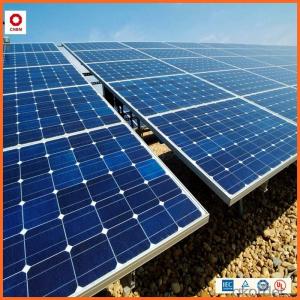CNBM Solar Home System Roof System Capacity-1000W
- Loading Port:
- Shanghai
- Payment Terms:
- TT or LC
- Min Order Qty:
- 5 pc
- Supply Capability:
- 30000 pc/month
OKorder Service Pledge
OKorder Financial Service
You Might Also Like
Introduction of Solar Home System
Solar Home System is composed by Solar Panels, Inverters, Charger Controller, Battery, Cable, Mounting Bracket, which is applied to produce electricity for home use.
Solar Home System is quite suitable product in urban area and the place which is short of electricity. Our Small Solar Home System own great benifits compare with other kind electricity resources:
Electricity generating cost of Solar Home System is much cheaper than diesel engine. Beside low electricity making cost, solar system products also have the features of noiseless, clean energy, environmentally friendly and can access to many different electric appliance.
Picture of Our Factory

Working Principle of Solar Home System
The stand alone Solar Home System is an off-grid solar system which uses batteries to store the solar energy. Stand alone solar system solutions design for those who are not able or willing to connect to electricity grid.
However, our on-grid solar home system can be connected to the grid for utilization of grid electricity power. Our solar system can add relative equipment as our customer’s requirement which have the function of switching to city electricity automatically. The solar system can use battery power in priority, if sunshine is not so good or loads consumption is too high which cause battery power insufficient. Then system can switch automatically to grid power supply. Meanwhile, the system can charge the batteries with grid power until batteries are fully charged. Then the solar system will switch back to battery power supply.
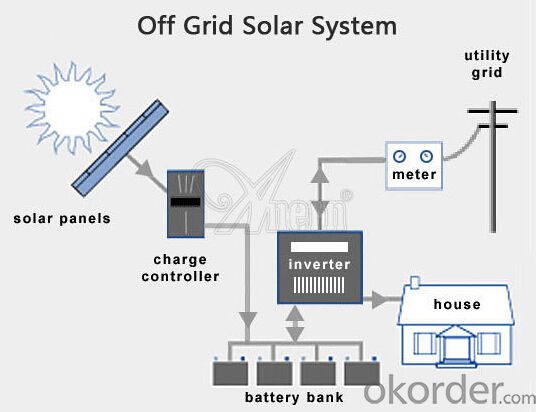
Product Details of Solar Home System
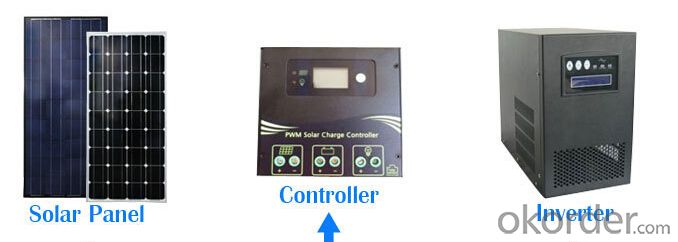
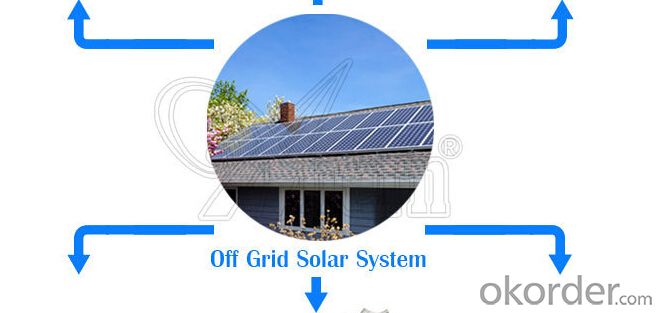

Specification of Solar Home System
Technical data: | ||||||||
Inverter | Rated load power | 1500W | ||||||
Output wave | Pure sine wave | |||||||
Input voltage | 24V | |||||||
Output voltage | DC:12V | |||||||
Output frequency | 50HZ/60HZ | |||||||
Precision of output frequency | ±6% | |||||||
Solar panel | Pmax | 167W*6PCS | ||||||
Vmp | 36V | |||||||
Imp | 27.8A | |||||||
Charger | Charger voltage & current | 24V/20A*3 | ||||||
Battery | Capacity | 12V/150AH*4PCS | ||||||
Power box | Spray paint iron box,with input,output, ammeter,voltmeter,master switch and so on. | |||||||
Package data: | ||||||||
Part | Size (L*W*H mm) | Weight (kg) | 20' (pcs) | 40' (pcs) | ||||
Power box | 580*520*540 | 60 | 96Sets | 240Sets | ||||
Solar panel | 1600*830*90 | 90 | ||||||
Battery | 540*520*350 | 220 | ||||||
Loading electrical equipment(For Consulting) | ||||||||
Name of Load | Power(W) | Quantity | Working Time per Day (H) | Working Days | ||||
Color TV | 65W | 1 | 6 | 3 days | ||||
Satellite TV Receivers | 25W | 1 | 6 | 3 days | ||||
lamp | 11W | 8 | 8 | 3 days | ||||
Computer | 150W | 2 | 6 | 3 days | ||||
FAN | 60W | 2 | 6 | 3 days | ||||
Other | 100W | 1 | 4 | 3 days | ||||
Advantage of Our Solar Home System
1 Excellent Performance: Our Solar Home System is composed by Brand Standard Kits with high quality. Our solar system has the advantage of high efficiency and stable operation. We can ensure our product with a long life period.
2. Small Orders Accepted: We can accept small orders as our customer’s trial order.
3. Warehouse: We have warehouse overseas which can bring great convenience to our customer to pick up the products.
FAQ
Q: Could you introduce the background of your company?
A: We are a Group corp. with 1GW capacity in China, which is Okorder’s registered VIP Supplier, possess Financial Service from Okorder.com.
Q: Required mainly certificates (CE&IEC/TUV/RoHS)?
A: Our products are certificated by CE RoHS, IEC, ISO, TUV, UL etc.
Q: Your main exported market is?
A: Main markets of our products is: South-east Asia, Mid-east, Arica, East Europe and Latin America.
- Q:How does a solar panel generate electricity?
- A solar panel generates electricity through the photovoltaic effect, where sunlight is converted into electrical energy. This process occurs when the photons in sunlight strike the solar cells within the panel, causing the electrons in the cells to be excited and flow as an electric current.
- Q:Can solar energy systems be easily expanded or upgraded?
- Yes, solar energy systems can be easily expanded or upgraded. The modular nature of solar panels allows for additional panels to be added to the system, increasing its capacity. Similarly, if more energy is required, additional batteries can be installed to store excess energy. Furthermore, advancements in technology and increasing efficiency of solar panels make it possible to upgrade existing systems with new and more efficient components, improving overall performance.
- Q:Can solar energy systems be used in off-grid locations?
- Yes, solar energy systems can be used in off-grid locations. Off-grid locations refer to areas that are not connected to the main power grid. Solar energy systems, such as solar panels, can generate electricity by harnessing the sun's energy and store it in batteries or use it directly for various applications. This makes solar energy a reliable and sustainable solution for powering off-grid locations, providing a clean and renewable source of energy.
- Q:Can solar energy systems be used in powering construction sites or temporary structures?
- Yes, solar energy systems can definitely be used to power construction sites or temporary structures. In fact, solar power is increasingly being utilized in these scenarios due to its numerous advantages. Firstly, construction sites often lack access to traditional power sources, which makes solar energy a practical solution. Solar panels can be easily installed on rooftops, scaffolding, or even on the ground, providing a reliable source of electricity throughout the construction process. Secondly, solar energy systems offer flexibility in terms of power generation. They can be customized to meet specific energy demands of construction sites, whether it is for running power tools, lighting, or charging equipment. This adaptability ensures that construction activities can proceed smoothly without interruptions. Additionally, solar energy systems are environmentally friendly. By harnessing energy from the sun, construction sites can significantly reduce their carbon footprint and contribute to sustainable practices. Solar power does not produce harmful emissions or noise pollution, which is particularly beneficial in urban areas or sensitive environments. Furthermore, solar energy systems offer cost savings in the long run. While the initial investment for installing solar panels might be higher compared to traditional generators, the ongoing operational costs are significantly lower. Construction sites can benefit from reduced fuel expenses, maintenance costs, and reliance on fossil fuels. It is worth mentioning that solar energy systems can also be used for temporary structures such as mobile offices, portable restrooms, or event venues. These structures can be easily powered using solar panels, eliminating the need for generators or grid connections. In conclusion, solar energy systems are a viable and sustainable option for powering construction sites and temporary structures. They provide reliable, customizable, and cost-effective power solutions while minimizing environmental impact. As the global shift towards renewable energy continues, solar power will likely become even more prevalent in construction industry practices.
- Q:Can solar energy systems be used for powering outdoor recreational activities?
- Yes, solar energy systems can indeed be used to power outdoor recreational activities. They can provide a sustainable and renewable source of power for various activities such as camping, hiking, and boating. Solar panels can be used to charge portable batteries or directly power devices like lights, fans, radios, and even small appliances. This allows outdoor enthusiasts to enjoy their activities while minimizing their environmental impact and reducing reliance on traditional energy sources.
- Q:What are the maintenance requirements for solar energy systems?
- Solar energy systems require minimal maintenance. The main maintenance requirements include regularly cleaning the solar panels to remove dust and debris, checking the connections and wiring for any signs of damage or wear, and monitoring the system's performance to ensure it is generating the expected amount of electricity. Additionally, the inverter, which converts the solar energy into usable electricity, may need to be replaced after around 10-15 years. Overall, with proper maintenance, solar energy systems can last for several decades with little to no issues.
- Q:Can solar energy systems be installed in areas with extreme weather conditions?
- Yes, solar energy systems can be installed in areas with extreme weather conditions. While extreme weather conditions such as extreme heat, cold, wind, or snow can potentially affect the performance of solar energy systems, modern solar technology has been designed to withstand these conditions. Solar panels are made from durable materials that can handle high temperatures, freezing temperatures, and strong winds. Additionally, solar panels are often tested and certified to meet specific industry standards for durability and performance in different weather conditions. In areas with extreme heat, solar panels are designed to dissipate heat and maintain their efficiency. They are also tested to ensure that they can withstand the high temperatures without any damage or significant loss in performance. In areas with extreme cold, solar panels are built to withstand freezing temperatures and can even generate electricity in snowy conditions. Some solar panels are designed with anti-reflective coatings to absorb more sunlight and melt snow faster. Furthermore, solar energy systems are often installed with proper mounting systems and structures that can withstand strong winds or storms. These systems are engineered to ensure that the solar panels remain securely attached to roofs or ground mounts even in areas prone to hurricanes or high winds. While extreme weather conditions can impact the performance of solar energy systems to some extent, with proper installation and design, solar panels can still generate electricity and provide a reliable source of renewable energy in areas with extreme weather conditions. It is important to consult with experienced solar installers or engineers who can assess the specific weather conditions of an area and design a solar energy system that can withstand those conditions.
- Q:Can solar energy systems be leased or rented?
- Yes, solar energy systems can be leased or rented. Many companies offer leasing or rental options for solar panels and systems, allowing individuals and businesses to access the benefits of solar energy without the upfront costs of purchasing and installing the equipment.
- Q:Can solar panels be installed on RVs or boats?
- Yes, solar panels can be installed on both RVs and boats. In fact, solar panels are increasingly popular for these applications as they provide a sustainable and reliable source of electricity while on the move. The panels can be mounted on the roof or in other suitable locations, and they help to charge the batteries and power various appliances and systems on board.
- Q:Can solar energy systems be integrated into building design?
- Yes, solar energy systems can definitely be integrated into building design. In fact, solar panels and other solar technologies are commonly incorporated into the design and construction of modern buildings. This integration allows for the generation of clean and renewable energy on-site and reduces dependence on traditional energy sources. Additionally, integrating solar energy systems into building design can help reduce greenhouse gas emissions and contribute to a more sustainable and environmentally friendly future.
1. Manufacturer Overview |
|
|---|---|
| Location | |
| Year Established | |
| Annual Output Value | |
| Main Markets | |
| Company Certifications | |
2. Manufacturer Certificates |
|
|---|---|
| a) Certification Name | |
| Range | |
| Reference | |
| Validity Period | |
3. Manufacturer Capability |
|
|---|---|
| a)Trade Capacity | |
| Nearest Port | |
| Export Percentage | |
| No.of Employees in Trade Department | |
| Language Spoken: | |
| b)Factory Information | |
| Factory Size: | |
| No. of Production Lines | |
| Contract Manufacturing | |
| Product Price Range | |
Send your message to us
CNBM Solar Home System Roof System Capacity-1000W
- Loading Port:
- Shanghai
- Payment Terms:
- TT or LC
- Min Order Qty:
- 5 pc
- Supply Capability:
- 30000 pc/month
OKorder Service Pledge
OKorder Financial Service
Similar products
New products
Hot products
Hot Searches
Related keywords
